In Market Access Map, the group of Commonwealth of Independent States (CIS) consists of 12 countries: Azerbaijan, Armenia, Belarus, Georgia, Kazakhstan, Kyrgyzstan, Moldova, Russia [1] , Tajikistan, Turkmenistan, Ukraine and Uzbekistan. Their intra-regional trade is connected by a network of CIS agreements.
In 1994, Azerbaijan, Armenia, Belarus, Georgia, Kazakhstan, Kyrgyzstan, Moldova, Russia, Tajikistan, Turkmenistan, Ukraine and Uzbekistan signed an agreement on a Free trade area (FTA) (the “CIS 1994”). In 2011, Armenia, Belarus, Kazakhstan, Kyrgyzstan, Moldova, Russia, Tajikistan and Ukraine signed another regional agreement (the “CIS 2011”) which superseded and cancelled CIS 1994 between the acceding member states. CIS 2011 was NOT signed by Azerbaijan, Georgia and Turkmenistan. Uzbekistan signed the agreement in 2013 and currently applies it with other signatories. In 2016, Russia and Ukraine bilaterally terminated CIS 2011 and currently do not have a bilateral preferential regime. Turkmenistan did not ratify CIS 1994 and did not sign CIS 2011, however Turkmenistan is covered by bilateral FTAs with most CIS countries, including all EaP countries [2] .
Rules of origin protocols governing CIS tariff preferences were signed and entered into force separately from CIS agreements. All countries that acceded to CIS 2011 apply CIS rules of origin protocol (ROO) 2009 among themselves except Uzbekistan and Turkmenistan. Azerbaijan and Georgia continue to apply CIS ROO 2000 with the other 10 CIS countries (on exports and imports). Exceptionally with Russia, Georgia applies special ROO in a bilateral FTA, and not CIS ROO 1993 which Georgia never signed. Uzbekistan and Turkmenistan continue to apply CIS ROO 1993 with other countries.
Additionally, in 1997, Azerbaijan, Georgia, Moldova and Ukraine established a regional organization GUAM [3] , but there is no free trade area in operation with distinct rules from CIS 1994. Since 2015, Armenia, Belarus, Russia, Kazakhstan and Kyrgyzstan have been member states of the Eurasian Economic Union (EAEU) which is a customs union. Since 2015, Uzbekistan has been conducting consultations with EAEU on a potential accession.
The current display in Market Access Map lists all participating countries of CIS FTA 2011 [4] (Illustration 1) and CIS FTA 1994 (Illustration 2). However, it does not take into account the complexity of bilateral relationships, such as absence of bilateral FTA relation between Ukraine and Russia in Illustration 1 and absence of bilateral FTA relation between Armenia and Azerbaijan in Illustration 2.

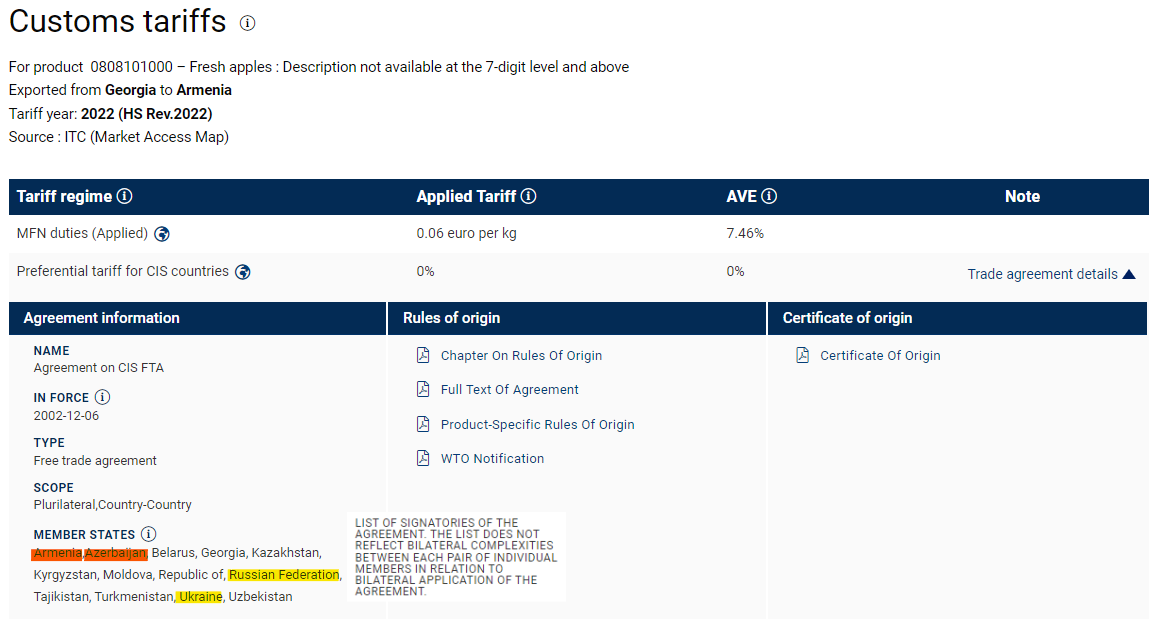
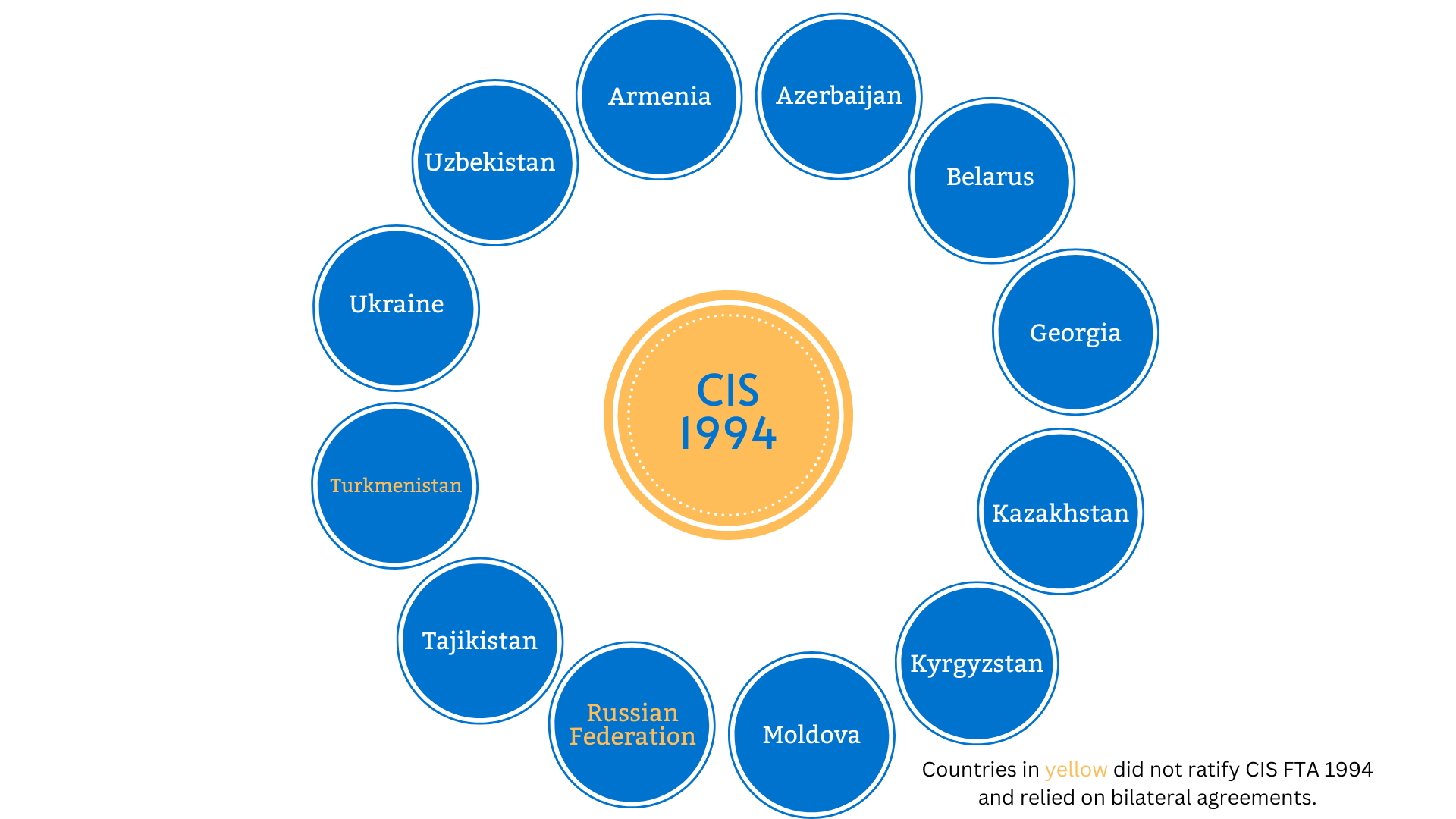
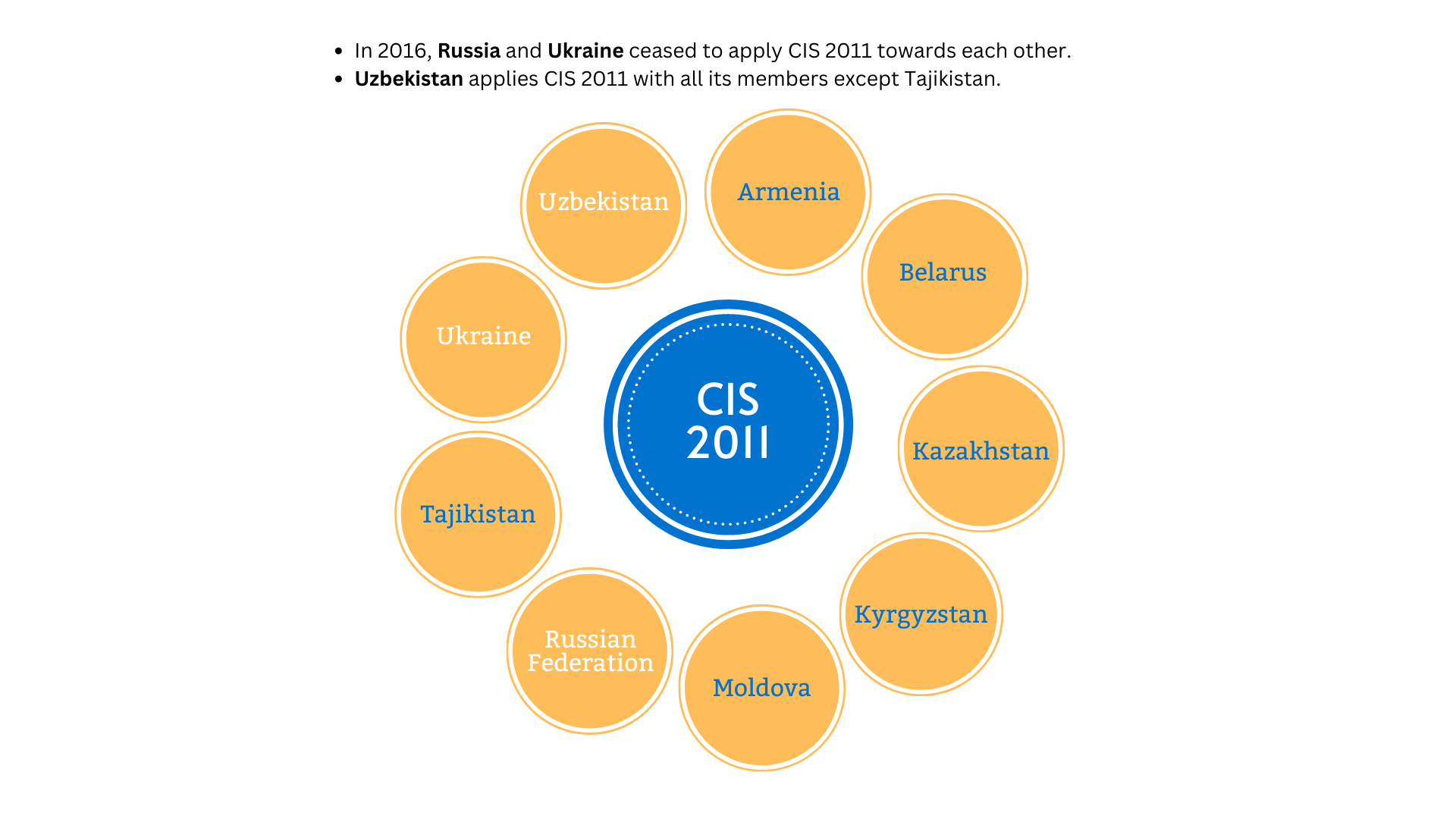
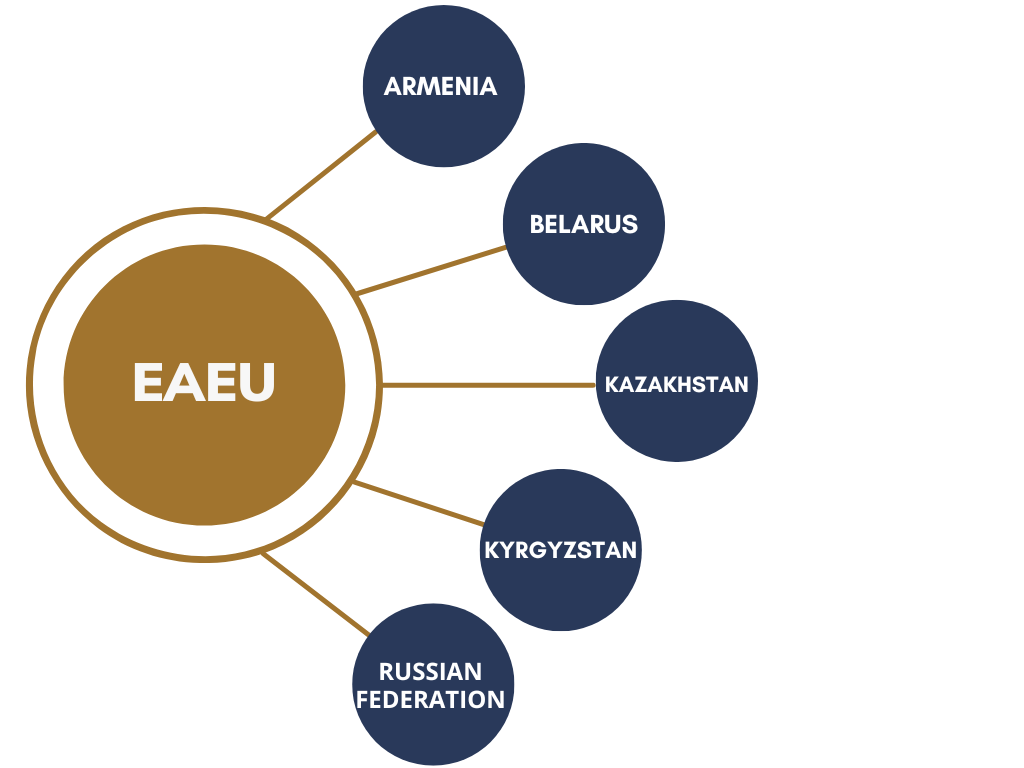
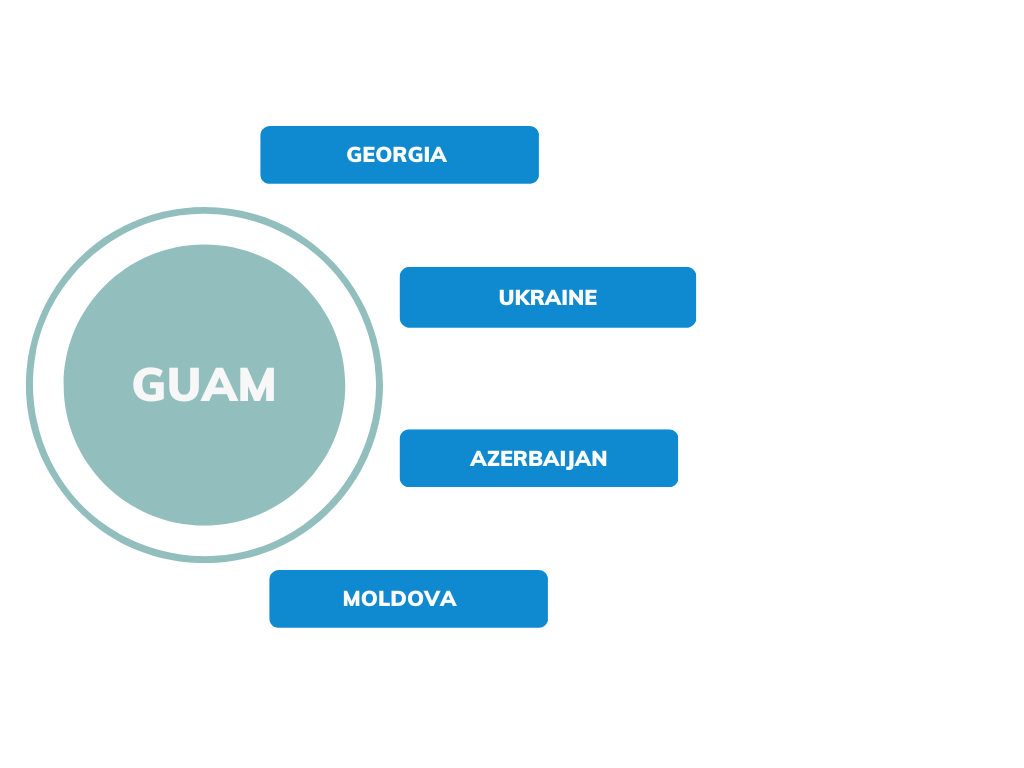
The FTAs and participating CIS members are visually summarized in Figure 1. The figure captures the state of application as of April 2022.
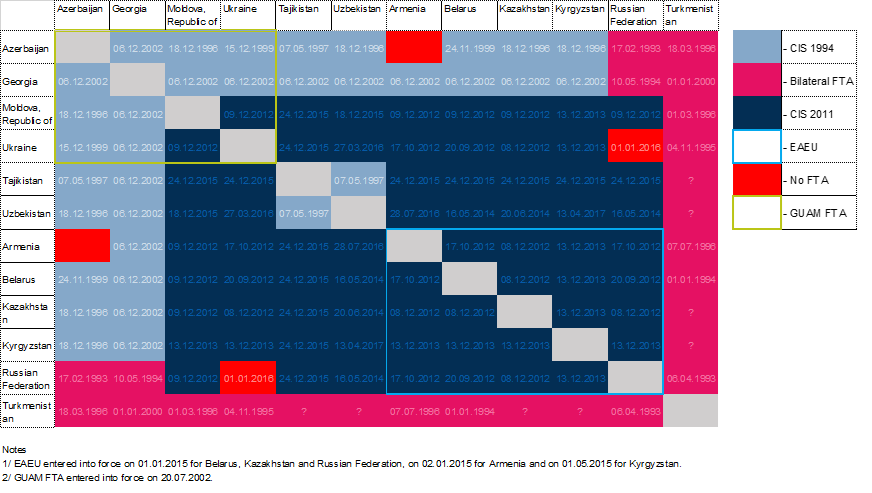
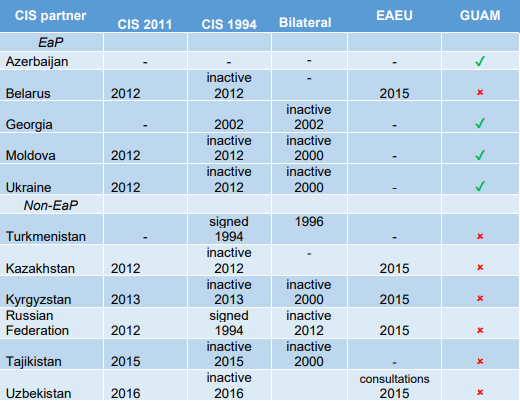
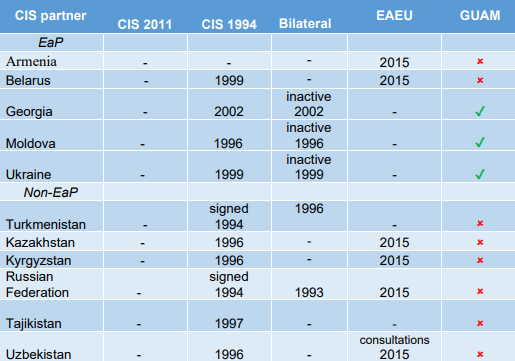
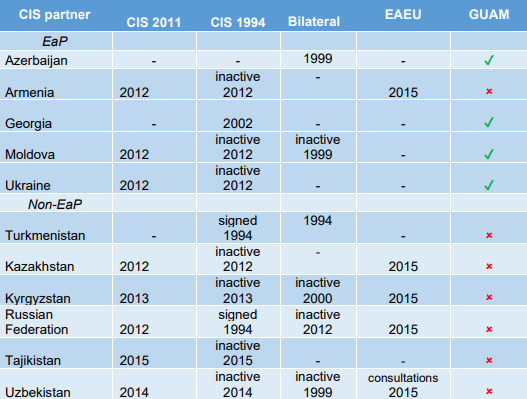
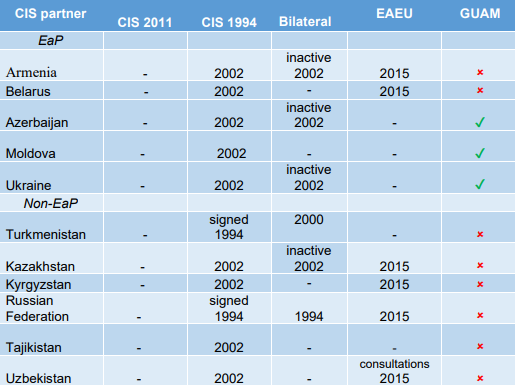
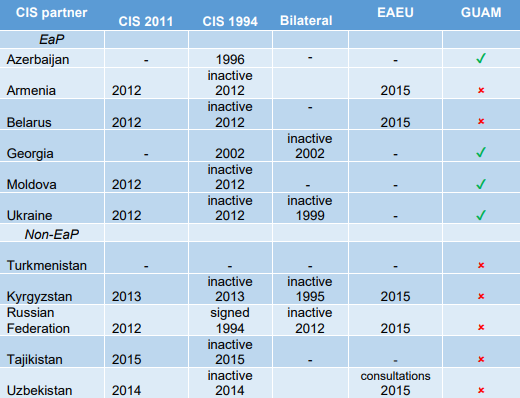
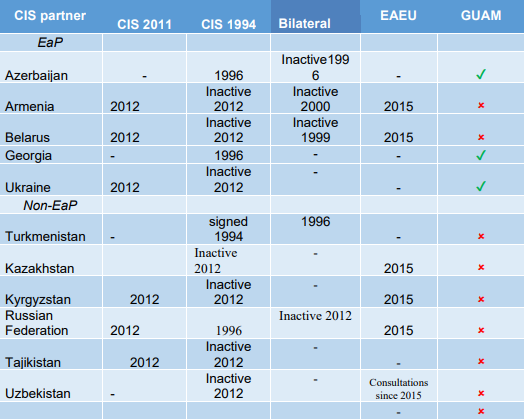

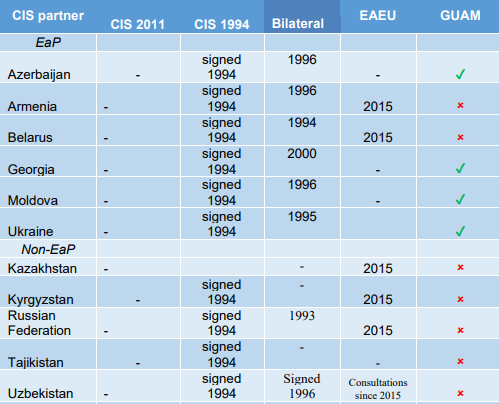
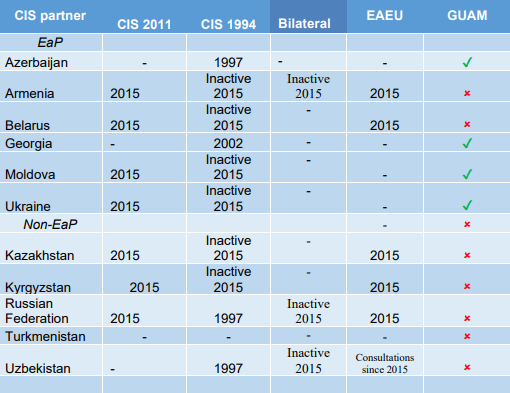
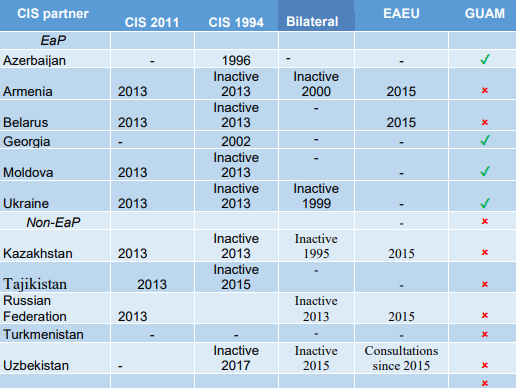
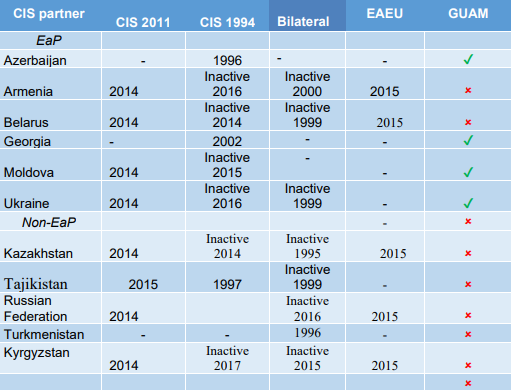
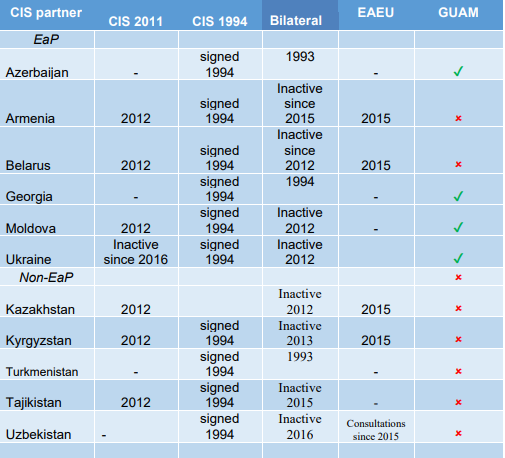
12 CIS countries signed multilateral FTA called “Agreement on CIS FTA” on 15 April 1994. Each country had to ratify it to bring into force, as well as to ratify the corresponding CIS ROO protocol of 1993 (see the text link below). Since it was not clear if all countries would eventually ratify CIS 1994, countries began signing bilateral FTAs, which referred to CIS 1994 as their base framework. CIS 1994 explicitly allowed signing of bilateral FTAs to bring CIS 1994 provisions into effect in a bilateral way. Russia and Turkmenistan declined to ratify CIS 1994, while other countries did. However, Russia had a bilateral FTA with each CIS country, effectively implementing CIS 1994.
In 2011, CIS countries signed CIS FTA 2011 called “Treaty on CIS FTA”. It was NOT signed by Azerbaijan, Georgia, Uzbekistan and Turkmenistan. Each country had to ratify to bring it into effect for itself. CIS FTA 2011 contained new ROO. Uzbekistan eventually signed in May 2013, and its accession instrument was later ratified bilaterally with each CIS member to bring Uzbekistan’s accession into effect. CIS FTA 2011 countries explicitly terminated CIS FTA 1994 between themselves. However, they continue to apply CIS FTA 1994 or bilateral FTA, as the case applies, with rest of CIS countries who did not accede to CIS 2011.
GUAM applies since 2003, and it refers to CIS FTA 1994 ROO on interim basis. But since all 4 countries are CIS FTA 1994 members already (except the bilateral pair of Ukraine and Moldova who apply CIS 2011), this FTA is considered redundant for the final display to users in Market Access Map. However, in this explanatory web page it is mentioned among the existing FTAs in the region.
Legal texts of ROO in CIS region:
CIS ROO 2009: http://cis.minsk.by/reestr/ru/index.html#reestr/view/text?doc=2739.
CIS ROO 2000: https://docs.cntd.ru/document/901777639#7DS0KE.
CIS ROO 1993: https://docs.cntd.ru/document/1900222#6540IN.
CIS Economic Court Decisions in relation to application of ROO:
19.06.2006 (N 01-1/5-05): https://zakon.uchet.kz/rus/docs/H060000445_.
10.04.2008 (N 01-1/5-07) : https://adilet.zan.kz/rus/docs/H080000455_.
20.05.2018 (N 01-1/6-07): https://docs.cntd.ru/document/902141153.
15.01.1998 (N 01-1/3-97): http://sudsng.org/database/deed/65.html.
From CIS Economic Court Decisions the following conclusions on application of ROO follow.
Uzbekistan and Turkmenistan did not accede to CIS ROO 2000. Hence they apply CIS ROO 1993 on imports and CIS partners have to apply them on exports from Uzbekistan and Turkmenistan (reference to N 01-1/5-07). Uzbekistan acceded to CIS FTA 2011, but in the legal text it says it still will use CIS ROO 1993 (reference to N 01-1/5-05).
Countries who acceded to CIS 2011 apply CIS ROO 2009 among themselves. It is all countries except 4: Azerbaijan, Georgia, Uzbekistan (see above) and Turkmenistan (see above). Azerbaijan and Georgia continue to apply CIS ROO 2000 with all other CIS countries (on exports and imports).
Georgia did not sign CIS ROO 1993 (see N 01-1/3-97). With Russia, Georgia applies special ROO in bilateral FTA.
CIS ROO 2009: Armenia applies CIS ROO 2009 with all CIS FTA 2011 signatories except Uzbekistan.
CIS ROO 2000: Armenia applies CIS ROO 2000 with Georgia.
CIS ROO 1993: Armenia applies CIS ROO 1993 with Uzbekistan and Turkmenistan.
CIS ROO 2000: Azerbaijan applies CIS ROO 2000 with all CIS countries except Armenia, Turkmenistan and Uzbekistan.
CIS ROO 1993: Azerbaijan applies CIS ROO 1993 with Uzbekistan and Turkmenistan.
CIS ROO 2009: Belarus applies CIS ROO 2009 with all CIS FTA 2011 signatories except Uzbekistan.
CIS ROO 2000: Belarus applies CIS ROO 2000 with Azerbaijan and Georgia.
CIS ROO 1993: Belarus applies CIS ROO 1993 with Uzbekistan and Turkmenistan.
CIS ROO 2000: Georgia applies CIS ROO 2000 with all CIS countries except Russia, Turkmenistan and Uzbekistan.
CIS ROO 1993: Georgia applies CIS ROO 1993 with Uzbekistan and Turkmenistan.
Georgia applies special ROO in a bilateral FTA with Russia.
CIS ROO 2009: Kazakhstan applies CIS ROO 2009 with all CIS FTA 2011 signatories except Uzbekistan.
CIS ROO 2000: Kazakhstan applies CIS ROO 2000 with Azerbaijan and Georgia.
CIS ROO 1993: Kazakhstan applies CIS ROO 1993 with Uzbekistan and Turkmenistan.
CIS ROO 2009: Moldova applies CIS ROO 2009 with all CIS FTA 2011 signatories except Uzbekistan.
CIS ROO 2000: Moldova applies CIS ROO 2000 with Azerbaijan and Georgia.
CIS ROO 1993: Moldova applies CIS ROO 1993 with Uzbekistan and Turkmenistan.
CIS ROO 2009: Ukraine applies CIS ROO 2009 with all CIS FTA 2011 signatories except Uzbekistan and Russia.
CIS ROO 2000: Ukraine applies CIS ROO 2000 with Azerbaijan and Georgia.
CIS ROO 1993: Ukraine applies CIS ROO 1993 with Uzbekistan and Turkmenistan.
CIS ROO 1993: Turkmenistan applies CIS ROO 1993 with rest of CIS.
CIS ROO 2009. Tajikistan applies CIS ROO 2009 with all CIS FTA 2011 signatories except Uzbekistan.
CIS ROO 2000. Tajikistan applies CIS ROO 2000 with Azerbaijan and Georgia.
CIS ROO 1993: Tajikistan applies CIS ROO 1993 with Uzbekistan and Turkmenistan.
CIS ROO 2009: Kyrgyzstan applies CIS ROO 2009 with all CIS FTA 2011 signatories except Uzbekistan.
CIS ROO 2000: Kyrgyzstan applies CIS ROO 2000 with Azerbaijan and Georgia.
CIS ROO 1993: Kyrgyzstan applies CIS ROO 1993 with Uzbekistan and Turkmenistan.
CIS ROO 1993: Uzbekistan applies CIS ROO 1993 with rest of CIS.
CIS ROO 2009: Russia applies CIS ROO 2009 with all CIS FTA 2011 signatories except Ukraine and Uzbekistan.
CIS ROO 2000: Russia applies CIS ROO 2000 with Azerbaijan.
CIS ROO 1993: Russia applies CIS ROO 1993 with Uzbekistan and Turkmenistan.
Russia applies special ROO in a bilateral FTA with Georgia.
[1] Official name for Russia in MacMap application is Russian Federation.
[2] Eastern Partnership (EaP) countries are considered Armenia, Azerbaijan, Belarus, Georgia, Moldova and Ukraine.
[3] Initially it was GUUAM. Uzbekistan was also a member of GUAM in the 1999–2005 period.
[4] Year of signature is used for simplicity of reference.
[5] Customs Union, not FTA.
[6] Texts of all identified bilateral FTAs in the framework of CIS 1994 are available inside document https://findrulesoforigin.org/documents/pdf/itc00659_full.pdf .
To access more features of the site, register for free in ITC's Market Analysis Tools platform
Register >>